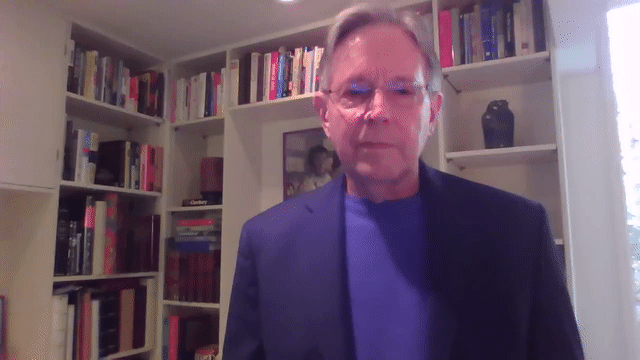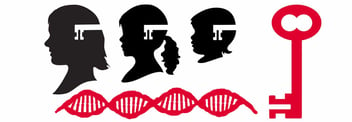Prescription Meditation from Genetic Testing?
- Home
- Blog

Biohacking Your Mental Health Ecosystem: Part Seven

My Dear Reader, the title of today’s blog does not contain a typo. I intended it as “meditation,” not “medication.” Here’s why. Wherever you are right now, I want you to close your eyes for a moment and just listen. What do you hear? If you live in a city, perhaps you hear the muffled buzz of a perpetual traffic jam just outside your window, or the roaring engines of the planes above taking off or coming in for a landing. In the midst of these work-from-home days, perhaps you hear the giggling of your children in the nearby room as their teacher cracks a joke from the Zoom screen. Now, move past the immediate sounds that greet your ear and listen closer. Maybe what you hear first is a comfortable pause—some semblance of an inner silence. Now count how many seconds (or milliseconds!) it takes for your internal monologue to chime in with today’s schedule of worries. Noise pollution is often used to describe those ambient sounds of the machinery that keeps our modern world going: construction, planes, trains, automobiles, and the like. But have you ever had an experience where you’re surrounded by complete quiet, yet still can’t seem to turn the volume down on your own mind? I know I have—and if you can relate, you know that this is a kind of noise pollution unto itself… and sometimes that inner noise can prove even more toxic than the kind coming from outside your window.
I don’t need to tell you of the many ways the ongoing pandemic has added to our collective struggle against the internal noise pollution of our anxiety, emotional distress, and upsetting thoughts. In prior blogs we have called this “Pandemic Anxiety,” as the anxiety itself becomes a form of contagion. With our communities remaining somewhere between half-open and fully shut down, the external noise has surely gotten a little quieter. But with more of us than ever stuck in our homes, with our screens serving as our biggest connection to the outside world, the world inside our own heads has seemingly grown louder than ever. Reader, if this sounds all too familiar to you I have some good news for you: unlike external noise pollution, there is a tool that each and every one of us has at our disposal to help us control the internal noise. It’s called meditation—and with just a little practice, it may have the power to alter not just your thought patterns, but also how specific genes can be “tweaked” to promote better mental health.
What is Meditation?
Over the last few years, “meditation” has become a cultural buzzword in the West—in fact, so many corporations and apps have now embraced it that the practice itself has gotten lost in translation. Even the word itself has become somewhat muddled. To some, “meditation” connotes a lofty spiritual practice only available to the most learned sage. To others, “meditation” is like yoga—an Eastern practice that has been coopted by a class of consumers who now use the term as a bragging right to demonstrate how “enlightened” they are. To others still, it’s a practice that may have some benefits, but who in the world has time to sit in silence for even a couple minutes a day?
Now I am no expert—even after traveling to Southeast Asia to learn about it firsthand from Buddhist monks, there is so much more I need to learn – but I do wish to provide a little clarity on this topic, because I have seen firsthand how impactful meditation can be to those whose inner noise pollution is just too much to bear. Not just for me, but for many of my patients as well. First, meditation does not require you to be a part of any spiritual tradition or secular practice. Second, it also doesn’t require any software, fancy pillows or cushions, calming candles, or any other sort of decoration. Third, meditation does not require any set time frame—much like exercise, this is not an all-or-nothing practice and even a few minutes can go a long way. In fact, all meditation requires is one simple thing that all living humans possess: the ability to breathe! In the Tibetan language, the word for meditation is “gom”, which roughly translates as “to become familiar with”. Indeed, at its most fundamental level, meditation is simply becoming familiar with your own breath. Popular meditation website Lion’s Roar puts it this way: To meditate, all you need to do is find a comfortable posture; notice and follow your breath; and if distracting thoughts, feelings, or sensations arise, simply note them and move your attention back to those inhales and exhales. As Lion’s Roar notes, the beautiful thing about meditation is that it’s impossible to fail—after all, it’s called a practice for a reason! Meditation is a constant process of getting distracted, noting the distraction, and returning to the breath—and if you practice enough, you will likely find that the returning part gets easier and easier.
The Sanskrit word for meditation is “bhavana”, which translates roughly to “to cultivate”—this provides yet another helpful insight into the basic practice of meditation. To meditate is to cultivate an inner quiet, to practice building a space for the mind to rest and take refuge amidst the onslaught of noise pollution we face every day from within and without. If your inner monologue feels like it’s screaming at you at all hours, demanding your constant attention, meditation is a tool you can use to tell your monologue to take a tea break—or, even better, a nap!
Pressing the Pause Button with Meditation to “Chillax”
I want to illustrate how to put meditation into practice by telling you a friend’s story that I bet many of my readers can relate to: During a recent visit to Montana, my friend found herself sitting out among the stars, on the deck of a house situated amidst a beautiful pine forest, a good twenty minutes away from the nearest town. With seemingly nothing to distract her besides a slight breeze, she closed her eyes for a few moments to observe the impenetrable silence of her surroundings. As she noted the sporadic noises that arose—a brief wind through the pine, birdsong somewhere in the distance—she began to feel a deep connection to the natural world in her midst. But after a few seconds of calm, her brain turned like clockwork to next week’s deadlines, to her worries about her aging parents in the pandemic, to her progressive weight gain—yet another product of the pandemic—and beyond. All that noise, despite the tranquility around her! What happened next only made things worse for her: She compounded those worries by administering a healthy dose of shame and guilt—I can’t even sit for one second without getting flooded by worries and my anxiety! For a moment, she contemplated just going inside and saving all that inner peace stuff for another day. But she paused and remembered that tool we all have: meditation. She said to herself, “If I take a five-minute break from these worries, they’ll surely be there when I return.” Instead of compounding the guilt she placed on herself, she simply noted it: “Wow—I’m being really harsh on myself. Let me take a five-minute break from that, too.” (In meditation circles this simple technique relates to something called “the bliss of blamelessness” – and who among us wouldn’t benefit from a higher dose of that?) With that, she pressed pause on all that negative noise pollution and with a deep breath she felt the weight of the world around her diminish. She “chillaxed.”
Don’t we all deserve that five minutes of peace? If so, how do we get there? Simply put, meditation helps us build that pause button—and helps us use it in times like this. By carving out a few minutes each day to cultivate an inner quiet, you are practicing setting boundaries on fears and worries rather than letting them seep into your every waking moment. It’s not about ignoring those anxieties—it’s about giving your brain some rest so that it can process those anxieties more effectively.
Scientific Proof that Mediation Improves One’s Mental and Physical Health
But building in an inner “pause button” is not the only benefit of meditation practice—far from it in fact. Studies have shown that this practice is powerfully effective at alleviating stress, increasing resilience, and even reducing chronic pain. As if that weren’t enough, this tool against mental noise pollution has also been shown to fight against inflammation, increase the health of our microbiome, and even reduce the impacts of normal aging on our brain by helping to protect our DNA from damage. If you’ve been following along with our blog, this list will tell you a lot about why I’m so excited to dig into the topic of meditation with you! The benefits of meditation touch upon every single one of our prior blog series, from Digital Downfalls to DNA: Nurture your Nature to Your Mighty Moody Microbiome. As we will learn in the coming weeks, meditation even has the power to altar the very expression of our human genome. This is incredible stuff—and the mountain of research describing the positive impacts of meditation on our overall health is growing every single day.
Can Meditation Biohack my Genes toward Better Mental Health?
There are many factors that contribute to our mental health, including everything from our social surroundings to our diet. But here at Potomac Psychiatry, we know that genes play a significant role in our wellness outcomes—which makes it all the more significant that new studies are showing that the benefits of a regular meditation practice run so deep that the very structure of our DNA’s expression is altered.
As you’ve read in prior blogs, certain parts of our DNA can be switched on or off depending on certain positive or negative environmental triggers through a process called epigenetics. For instance, if you have a specific variant on your OPRM1 gene, you could be predisposed to alcoholism. An alcoholic drink may act as a trigger that switches that variant “on”. Recent studies have found that meditation is another kind of trigger—one that has the power to switch on gene variants that can have a significant positive impact on our mental wellbeing.
Meditation, Genetic Testing, and BDNF, SLC6A4, and FKBP5 Genes
In prior blogs we have written about each of these genes, and described how to uncover their hidden effects on our mental health, using genetic tests such as Genomind’s Professional PGx and Mental Health Map. Scientific research has demonstrated that meditation epigenetically affects these genes to promote better mental health. Let’s begin with just one of these genes, BDNF, and in the coming weeks we will address the effects of meditation on each of them.
The BDNF gene is one we’ve discussed at length on this blog, and for good reason: known as the brain’s “fertilizer gene”, BDNF enhances our neuroplasticity (forming new connections between brain cells to learn new information, and then protecting them) and memory, increases cognitive functioning and creativity, and is the foundation for increasing the manufacture of critical mental health neurotransmitters like dopamine and serotonin. Meditation has been shown to epigenetically alter the BDNF gene so that it produces more of the “fertilizer” proteins, thereby increasing all these cognitive capacities and more!
Biohack Brain Health through Meditation!
Reader, Potomac Psychiatry prides itself on staying on the cutting edge of scientific research as it pertains to determining the root causes of mental distress and how to correct them—and there’s more than enough evidence to suggest that meditation is a valuable epigenetic tool to add to our mental health toolkit. From giving us a break from our internal noisy monologue to increasing our emotional resilience and cognitive capacities via epigenetics, meditation has plenty of benefits, and we hope you’ll take note and begin to practice it. If this blog leaves you curious, that’s a good thing: Much more is coming in the following weeks as we take a look at this research together, and demonstrate the power of cultivating an inner peace amidst our noise-polluted lives!
Other Biohacking Tips to Beat COVID
Learn more about Biohacking Your Genes to “Beat the COVID Blues”
.png?width=144&height=144&name=Untitled%20design%20(34).png)



